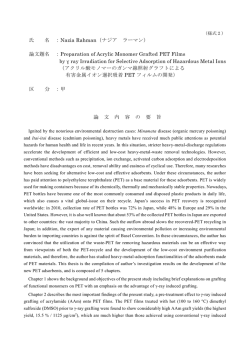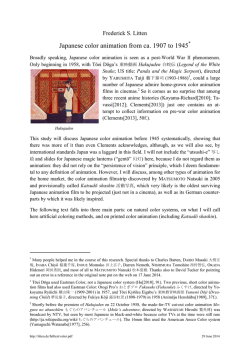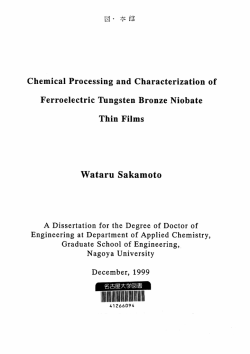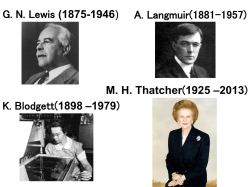
Nanostructural Control of Biological Molecules
1 Nanostructural Control of Biological Molecules Arranged by Using Langmuir-Blodgett Films of Organo-modified Alminosilicate as a Template Shuntaro Arai1, Jun-Ichi Kusaka1,2, Munehiro Kubota3, Kei-ichi Kurosaka3,and Atsuhiro Fujimori1,* Graduate School of Science and Engineering, Saitama University, 255 Shimo-okubo, Sakura-ku, Saitama, 338-8570, 2Graduate School of Science and Engineering, Yamagata University, Yonazawa, Yamagata, 992-8510, 3Kunimine Industries Co., Ltd. Iwaki, Fukushima, 972-8312, Japan. 1 (Received <Month> <Date>, <Year>; CL-<No>; E-mail: [email protected]) Clay Langmuir-Blodgett (LB) films play a template role in the formation of the lysozyme thin layer. Confirmation of chemisorption of biological molecules to the anionic montmorillonite surface is performed by comparison between IR spectra of multilayers of organo-clay and one chemisorbed lysozyme. The difference between height information of monolayers for only organo-modified alminosilicates and their adsorbed lysozyme indicates about 9 nm. This value is almost corresponded to twice for length of lysozyme along the long axis. Layered silicates, clay minerals, have played important roles in the modern technology.1 These materials have received considerable attention because of their potential use in numerous technical applications, ranging from nanocomposite materials to biomedical and personal care products.2 Clays are unique in the sense that they consist of negatively charged aluminosilicate layers kept together with exchangeable interlayer cations. Hence a large number of alkylammonium-modified layered silicates (organo-modified clays) have been developed, which are now widely used to form a large variety of nanocomposite materials with enhanced material properties.3 The Langmuir–Blodgett (LB) method is one of the most useful techniques to prepare ultra-thin films. In this method, floating molecular monolayers formed at an air/water interface are deposited on a solid substrate in a layer-by-layer way. Ultra-thin films of clay minerals were prepared by the LB method. Recently, the clay LB films have been hybridized with alkylammonium cations. When a solution of an amphiphilic alkylammonium salt is spread onto the clay suspension, the negatively charged clay platelets in the suspension are adsorbed onto a floating monolayer of the alkylammonium cation at an air–clay suspension interface. Previously, authors have reported formation of organomodified montmorillonite with extremely high surface coverage and localized negative charges in the bottom by modification method in oil/water interface.4-8 In this work, floating monolayers and multilayered films on solid of pre-formed organo-modified montmorillonites (MMTs) with high coverage and localized nagative carges in the bottom were constructed by Langmuir and LB method. In this case, buffer solution conatining lysozyme as cationic biomolecule have been used as subphase. The organomodifed alminosilicate LB films play a template role in the formation of the adsorbed lysozyme array. These LB multilayers of organo-modified MMTs adsorbed an enzyme were characterized by the π–A isotherm, infrared (IR) spectroscopy, and atomic force microscopic (AFM) observation. Natural Na+-montmorillonite was kindly supplied by Kunimine Co. with the cation-exchange capacity of 108.6 meq/100 g. The organophilic clay was prepared by cation exchange reactions of natural clay (aqueous dispersion) with 0.1 % aqueous solution of dimethyl dioctadecyl (DMDO) ammonium chloride. Four kinds of quaternary ammonium cations based on long-alkyl chain are used to hydrophobic parts of clays. In order to estimate hydrophobicity and ability of formation of ordered organized film, organo-modification agent having two alkyl-chains (DMDO) are applied. In this study, lysozyme were used as water-solved biological cationic enzyme (isoelectric point: pH11). The organo-modified clays were spread from toluene solution (approximately 10–4 M) onto buffer solution composed distilled water (approximately 18 MΩ·cm) containing lysozyme molecules. These monolayers were transferred onto CaF2 (IR samples) or mica (AFM samples) substrates at 15 °C using the LB and horizontal lifting method. IR spectra measured by system 2000 spectrometer (Parkin-Elmer Co. Ltd). The surface morphologies of the transferred monolayers were observed using a scanning probe microscope (Seiko Instrument, SPA300 with SPI-3800 probe station) at tapping mode utilizing microfabricated rectangular Si single crystal cantilevers with integrated pyramidal tips with a constant force of 1.7 Nm-1. Figure 1 shows IR spectra of LB multilayers of organomodified clay and they adsorbed lysozyme. In the case of monolayer on the water surface, obviously expanded tendency of π-A isotherm were confirmed in that adsorbed lysozyme (data not shown). The characteristics of spectrum in fig. 1(a) (a) vSi-O (b) vc=o vN-H Wavenumber / cm-1 Figure 1 IR spectra of multilayers for (a) organomodified alminosilicates (20 layers), and (b) their adsorbed lysozyme. (b) (a) 0 [μm] 1 0 3.6 [nm] 0 [μm] 1 13.0 [nm] 0 Figure 2 AFM images of X-type monolayers of (a) organo-modified alminosilicates and (b) their adsorbed lysozyme (pH 7, 30 mNm-1, and 15 °C). is existence of clear C-H and Si-O stretching vibrations. These bands based on the long alkyl chain on clay surface and silicate layers. In fig. 1(b), bands of vC=O and vN-H are clearly confirmed. These bans come from carboxyl and amino groups in lysozyme. Therefore, it seems that this result supports adsorption of biological enzyme to monolayer of organomodified MMTs. Figure 2 shows morphological estimation of these organized molecular films by AFM observation. The films shown in figs. 2(a) and (b) are corresponded to the X-type monolayers transferred by horizontal lifting method. Namely, both films expose hydrophilic clay surface or that adsorbed enzyme. In comparison of these images, the most important characteristic is difference between height information. Neat organo-clay monolayer have alkylated part with 2.5 nm and MMT part with 1.0 nm thickness. The height information in fig. 2(a) is well-corresponding to these values. This experimental fact indicates normal orientation of monolayer of organo-modified MMT on solid. From the result of fig. 2(b), the height information of adsorbed film indicates to 13.0 nm. The height of lysozyme along the long axis are corresponding to 4.5 nm9. Therefore, it seems that bimolecular layer adsorbed to MMT surface of normal oriented monolayer to the substrate. This speculation is supported by result of polarized IR spectroscopy and out-of plane X-ray diffraction at low angle side to their multilayers on glass substrate. Figure 3 shows schematic illustration of model of adsorbed double layered lysozyme / organo-modified alminosilicate monolayer on solid. It seems that interaction of Figure 4 AFM images of X-type monolayers of organomodified alminosilicates adsorbed lysozyme (pH 4 and 7, 10 mNm-1, and 15 °C) adsorption of cationic enzyme to the MMT correspond to electrostatic force. In addition, origin of formation of double layer structure for lysozyme assembly may correspond to COO–∙∙∙+H3N- interaction. Indeed, the adsorption condition of organo-MMT monolayer to cationic enzyme on air/water interface are pH7 and 30 mNm–1 in isotherm, and 15 °C in this case. Especially, high surface pressure condition of film transferring is easy to occur formation of piled up molecular film. Figure 4 shows adsorbed surface morphogical changes in X-type monolayer of organo-modified MMT depended on the transferring surface pressure and pH. In the case of low transferring surface pressure, low density single layered adsorption structure of lysozyme on organo-MMT monolayer are observed. Further, the amount of adsorbed enzyme increase with acidic condition10. Previously, dense packed lysozyme molecule observed by molecular resolution STM image. In the case of high surface pressure condition, formation of same type assembling structure are predicted. However, these like supramolecular structure generally lose an inherent activity of hydrolysis to saccharide. As mentioned above, organized molecular films of adsorbed enzyme have been constructed by means of the modified LB method using an organo-modified alminosilicate. In addition control of an amount of adsorbed molecules, adsorbed density, and adsorbed style is important to aiming at construction of new nanobio-materials. References 1 2 3 4 5 6 7 8 9 Figure 3 Schematic illustration of model of adsorbed double layered lysozyme / organo-modified alminosilicate monolayer on solid. 10 P. C. LaBarton, Z. Wang and T. Pinnavaia, J. Appl. Caly Sci., 15, 11 (1999). M. Alexandre and P. Dubois, Mater. Sci. Eng., 28, 1 (2000) R. A. Vaia, H. Ishii and E. P. Giannelis, Chem. Mater., 5, 1694 (1993). K. Kurosaka, M. Kubota, A. Fujimori, Japan Patent (2009), and (2011) A. Fujimori, J. Kusaka, R. Nomura, Polym. Eng. Sci., 51, 1099 (2011). A. Fujimori, SPE Plastic Res. Online, No.7, 1, (2011). A. Fujimori, J. Kusaka, M. Kubota, K. Kurosaka, RFP International, 6, 216 (2011). A. Fujimori, Y. Sugita, H. Nakahara, E. Ito, M. Hara, N. Matsuie, K. Kanai, Y. Ouchi, K. Seki, Chem. Phys. Lett., 387, 345 (2004). H. Shirahama, J. Lyklema, W. Norde, J. Colloid Interf. Sci., 139, 177, (1990) L. Haggerty, B.A. Watson, M.A. Barteau, A. M. Lenhoff, J. Vac. Sei. Technol. B, 9, 1219 (1991). 3 Graphical Abstract Textual Information Description (if any) Title Nanostructural Control of Biological Molecules Arranged by Using Langmuir-Blodgett Films of Organo-modified Alminosilicate as a Template Authors’ Names Shuntaro Arai, Jun-Ichi Kusaka, Munehiro Kubota, Kei-ichi Kurosaka, Atsuhiro Fujimori Graphical Information Ultrathin films of regularly adsorbed biological molecules were fabricated by means of the modified Langmuir-Blodgett (LB) method using an organo-modified alminosilicate. SubmissionFormbr ChemistryL(細ers 1,Manuscript¶t−e‥偏諒水晶日詰高抽増刷帰心A佃再♭ 仙最Y−射。1 副手木上式机 両㍉謡長日晶両市長叫べ1q恥 2・Au叫S)=血品も恒泣/フ町拭Kuも巌′州…由り緑轟 緑木止、K腑∼巌 3・EditoriaISuPiectlndex 粗忽鹿ノ〝2C鹿C櫓欄血呼卿おお∂呵妙 □1Ana研CalChem勒andSpectroscopy □2PhyskaIChem的:ShdursandProFX,rbes □3PhyscalChemisby:Reactions □4NudearChem蔭byandEnvirmmentaJChemisby ロ5El∝抽1em的 □6lnorgank:andC∞rdinatbnChemi的y □7Cata吋SisandCa胞研CReacCons 口8CrystaJIographyandMatehalSdence(lnorganic) □90rganometallicChemisby □110rganicChemistry:Mechanisms ロ120rganicChemistry:Reachns u130rganicChemistry:Syn廿1eSeS □14NaturalPrductsandMedidnalChemistry □15Bi∞rganicChemistryandBo∝hemisby 誹認芸慧簑霊謁慧器.㌘輌 □18Moel鹿,Layers,andFilm D19EnergyandNaturalResources ロ10 0rganicChemjsbySbtJCtu怜S 4.TheSupplementaIlnfbmlation l・∵∵㍉∵∵十∵∴∴_1− ∴∴∴l ∴− ̄ 5・DetaiIedJnfbrmabonontheAuthorfbrCorrespondeoe 叫l〟だ肌打′′/…‘Ⅳ川ヴ抽馳‘J′叩′川軽め〟0両炉′抑制‘〟…血J/油点画血批痛.極細∫ピ、 Iluea。dName= Dト蟻品。盲も\叫\ 氏名(姓名): A刊a仙〕∩:恥舟山 LLh日南血細い巌㈹品叫バ品師川和ふ 所属機関: 良等軋沌1号研 Dept.,Dh/.,Lab∴tV31呵1L軋h, 部署・研究室名: ZlP/Postalcode:う5%−BslO Add陀SS:・lgSsl晶㍉晶叫ぶ両石蝕バ鵡湘 住所=由、誓、1、、伍引航吊八軋郎 監禁竺7品認諾)=璃卜里巨駈弓摘 Extensionnumber Withcoun M血1血pIN皿It旭■ R銘々iYedDa短 (0爪OeU光0叫) THECHEMICALSOCIETYOFJAPANt’ldleCSJ”) COPYRIGHTTRANSFERFORM N独180FCb餌血Sode呼OrJ叩軋血伽押上伽 侮地。地血眈血軋帆鴫信じ晶久l 諦hl式鋸晶h川長Ji∼A†冊轟‖り眠来 し里中坤車丹亙れ仲里適も紺軌流転k臥S へ「と高良 TheAu血ot亘=names andamiatlOrLSl.Pleasenole:allAutllOrS muSthaYekninfbnnedofthe fdlcontentofthemanuserlplalthe血亡Ori血血l 地肌吊hh帰J hl武 ふ己1ぅ肌≠恥に。ふ†烏卜成≠h止∴娠歳M晶記 二手≒千二三二∵二三∵ ̄二二 ̄===二三二二 ̄ 慧霊篭志競慧還暦豊還芸濃宗怒慧謁監禁謡㌍丑印加a血痕)血曲咄鮎A噸S)血 監蔓琵還璧簑監憲茎還憲還憲野鶴霊錯若継蒜霊慧 諾藷蓬蓬沸 1.Copy嘲tTmもS蝕・ Slか追C也錐.TbeCSJ斑払y鋸追ordi血te也8m皿血pt頑張najoⅦ血,Oni短OWn,OrWi蝕ぬ訂r曲td魚油衰扇. 2.TheCSJCopy嘲tOv鋸椚血匝 、藁 準蕪 王tis伽飴n混1匹ikyof払eCSJtooⅥ1触cop画紳tsb撼copy廃船鱒仙準鱒由窄t∝i血dp血lk通例拶むidto鮎血血扇血扇601血b血0鮎 血Iab8父Sandsimibrpublic81ions、 3.如油症触叩帥血肋短 (わ也e5血技ed伽dptis也eorig血dworkof也eAllt王相互S)mdnotc。Pd(hp血okH汀inp訂t)録omanyo也αWO奴orma壮訂Or(打払e m即購旧知th叫d甲仲野丘かWO恕or卿nSO血ぼ也皿鮎Aぬ叫S))ぬe伽腿d印is血咄伽0軸i血wo夜of鹿血ぬ叫$)郷dall 蒜済時宗盲麗㌍血舶r混OrS血opy咄㈲由or鼠血血鱒OnS・王触郎融弟血e鱒0紬“COPⅧG訂 (b)触emanl誓車bs加tb饉na細W虫lnot画orbp鹿追は血nby鮎CSJt杷匹b独由一丁も由加lu血sb血p血も衰弧dd印加血押印血臨一 (Cも箪鍔禁窓檻慧慧禁等怒柳馳ぬ紬mw紬t抽聯鹿叩榊0坤師OnOr刑紬呵b融of 4.Retahd鞄も抽TermS的dCOndは0やS TbeAutho*)rnay,雨也outseekingpemission蝕m払eCSJ,PrOVided血tcopy頑tcredltisgiventc>thesol那e狐dtheCSJ,仇atrecipientsare idbmdll∝e岱ad砂地也野m町nOt餌也erdi£em血akOrCOpy也em独脱出が. 至芸憲送還認諾還窯芸整笠認諾蒜等盟諾慧認慧霊≡;C叩On血g ;選憲憲還…憑莞竃慧還諾意還諾還済慧‡芸慧 A叫r(S)works; (e)托Vl能OJa血pttkmamはdptandr印rOducea血ptah0鮎Of払e欄湖既r桓tfbr叩pllr押紙0也er他紙蝕ecommerd由宇Xploiぬnoram好個Cdが (青票震肇監血咄孤do蜘兜00m血摘M坤b鮎画hch画p闇ぬ頼地g伽紀禦駅 8ccOmPaJliedb)’VisualllⅦten且IsuchasslideS.O、■eItlCadsanJCOmPuterprqeCtions)、 Th¢A血ヰS)Im或$血血taWd触弧l明眠或ぬ血eCSJfbf堆yO蝕α闇e蝕抽蝕0父$鱒i蔦dhCk朋e4.AllCa鋸SOrr甲血licatio血管pr血tionmu威ね 拡CO叩anidbyanacknowl鳴em孤もOf触pめlica蛙onof蝕e馳紅dpt桓也eCSJ弘也ebm: (Ol唱inalcitattonトReproducedbI■阿TtlissIOtlOflbeChemicalSoCietyolJalnn S‡GNEDby血eAl血ororby oomonedtllyau蝕0血dbs短nfbr蝕ecopyngbトhold訂 Si多血re鳥l\叫し。AYか\ N叫p叫ゝL“ん。Ar品 Dak:恥71172嗅 Dぬ触感oll=1meCbemiedS加地yorJ呼孤Will或Or替地母娘brm感bny測S呼ply叩itBel顔如血托00曲ino虚血虚i臆rm衰皿ab湧ぬadi血iそらp相知由and SeⅣi聯maybese血to野心by輌鴎td叩ho鮒,払mail,Or魚乳 好y㈹朗やndam甜加r膿dyowDONOTwぬ10r鰐eiw伽i喝がe堰鱒talickin血¢box.□
© Copyright 2026




